Traditional Chinese Artists Used the Oldest Painting Medium in Continuous Use
China is one of the oldest civilizations in the world, with a continuous history that spans thousands of years. With its culturally rich history, Chinese artists over the centuries have crafted brilliant depictions of nature, figures, and animals with expert precision and detail. These artworks display an array of distinctive styles and remarkable characteristics that record China's storied art history and reflect its magnificent landscapes. Keep reading to reveal our selection of the 10 most famous Chinese paintings!
Table of Contents
- 1 A Brief Overview of Chinese Paintings
- 2 10 Most Famous Chinese Paintings
- 2.1 Five Oxen (8th Century) by Han Huang
- 2.2 Travelers Among Mountains and Streams, Northern Song Dynasty (c. 1000) by Fan Kuan
- 2.3 A Thousand Li of Rivers and Mountains (c. 1113) by Wang Ximeng
- 2.4 Along the River During the Qingming Festival (Early 12th Century) by Zhang Zeduan
- 2.5 Nymph of the Luo River (c. 344 – 406) by Gu Kaizhi (Song Dynasty Copy)
- 2.6 Emperor Taizong Receiving the Tibetan Envoy (14th Century) by Yan Liben
- 2.7 Spring Morning in the Han Palace (c. 1552) by Qiu Ying
- 2.8 Flower Study (17th Century) by Yun Bing
- 2.9 Flowers and Butterflies (Early 18th Century) by Ma Quan
- 2.10 Twin Swallows (1981) by Wu Guanzhong
- 3 Frequently Asked Questions
- 3.1 What Are the Main Types of Chinese Paintings?
- 3.2 What Are the Characteristics of Chinese Paintings?
- 3.3 Why Is Chinese Art Important?
A Brief Overview of Chinese Paintings
As one of the most culturally distinct nations, China has a rich art history. When viewing these incredibly expansive paintings, some spanning over 11 meters long, the viewer takes part in an interactive ritual. We are presented with a visual feast, where we leave our world and move into the world of the painting. Many of the famous Chinese paintings held in high regard were landscape paintings, as they were seen as the highest form of art in China.
Chinese artists have produced some of the world's greatest landscape paintings.
 Peach Festival of the Queen Mother of the West (17th-18th century), a Chinese Ming or Qing dynasty handscroll painting by an anonymous artist (formerly attributed to Fang Chunnian (ca. 1225-1264);PericlesofAthens at English Wikipedia, Public domain, via Wikimedia Commons
Peach Festival of the Queen Mother of the West (17th-18th century), a Chinese Ming or Qing dynasty handscroll painting by an anonymous artist (formerly attributed to Fang Chunnian (ca. 1225-1264);PericlesofAthens at English Wikipedia, Public domain, via Wikimedia Commons
The traditional style of painting used in China, before the popularization of Western styles in the 20th century, involved similar techniques to those used for calligraphy. Artists dipped their brushes in black ink or colored pigments, but oils were never used. The favored material for the base of these paintings was silk and paper. Most Chinese paintings were then secured on scrolls, including handscrolls and large hanging scrolls.
Traditional Chinese artwork could also be mounted on walls, featured on folding screens, album sheets, and various materials.
 An example of a hanging scroll from the Ming Dynasty (between c. 1368 and c. 1644);Rijksmuseum, CC0, via Wikimedia Commons
An example of a hanging scroll from the Ming Dynasty (between c. 1368 and c. 1644);Rijksmuseum, CC0, via Wikimedia Commons
There were two primary techniques used for ancient Chinese paintings. The first technique is known as Gongbi, which translates to "meticulous", where artists would capture scenes and figures with very precise and detailed brushstrokes. The results were often saturated in color, depicting narrative or figural subjects.
This style was a popular choice for artists who worked in private workshops or for the royal court.
The second technique is ink and wash painting, which has also been referred to as brush or watercolor painting, and literati painting. This technique was practiced mainly by gentlemen. The paintings were typically monochrome and were achieved by using black ink in varying concentrations.
10 Most Famous Chinese Paintings
Chinese paintings demonstrate some of the longest-held artistic traditions and disciplines. They were executed with exacting precision and expertise. Let us explore the phenomenal artistry of famous Chinese artists, as we unveil our selection of the 10 most famous Chinese paintings.
Five Oxen (8th Century) by Han Huang
| Artist | Han Huang |
| Date Painted | 8th century |
| Medium | Ink and color on paper |
| Dimensions | 20.8 cm x 139.8 cm |
| Where It Is Currently Housed | Palace Museum, Beijing, China |
Han Huang was a prime minister in the Tang Dynasty (618–907) and a celebrated artist. Huang painted Five Oxen during the 8th-century when he was alive (723–787). During Beijing's occupation in 1900 by the Eight-Nation Alliance, the painting was lost, but it was later recovered in the early 1950s in Hong Kong from a collector. Five Oxen, stretching at 139.8 cm wide and 20.8 cm long, now sits in Beijing's Palace Museum.
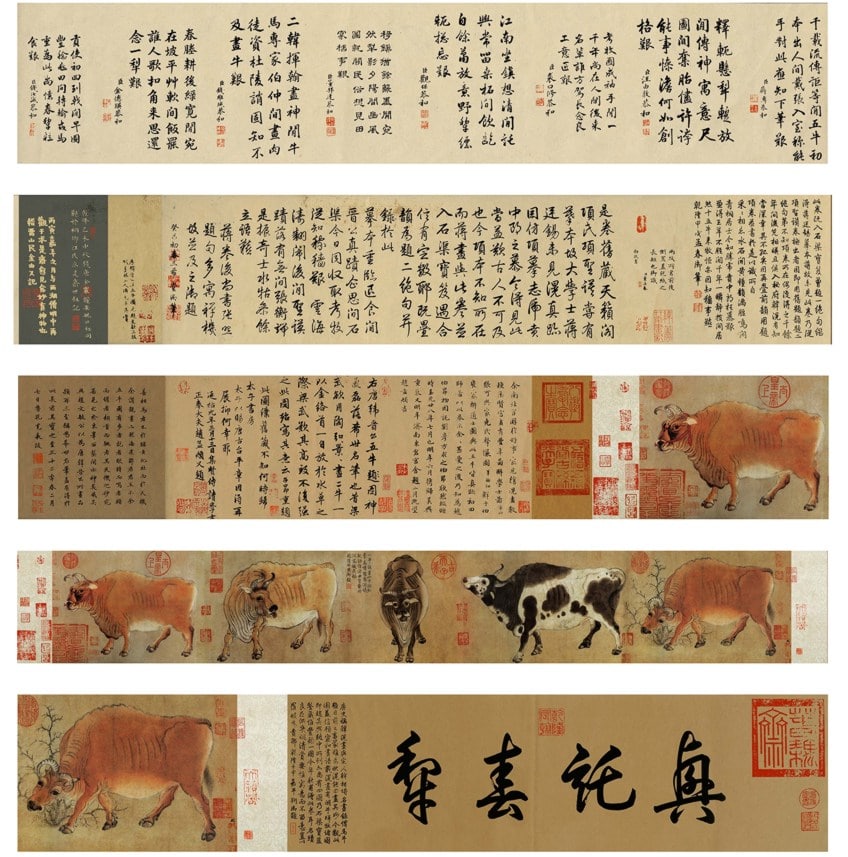 Five Oxen (8th century) by Han Huang, one of the rare extant paper paintings of the Tang Dynasty (618-907);Han Huang (韓滉), Public domain, via Wikimedia Commons
Five Oxen (8th century) by Han Huang, one of the rare extant paper paintings of the Tang Dynasty (618-907);Han Huang (韓滉), Public domain, via Wikimedia Commons
Five Oxen was depicted on flax paper with features typical of the Tang Dynasty. Huang depicted his five oxen in various colors and postures, with earthy, heavy, and thick brushstrokes. They are either standing or walking, bowing their heads or holding them high, each portrayed with a striking appearance. The central ox was crafted from a frontal angle, demonstrating Huang's remarkable modeling skills.
Huang went into extraordinary detail; their muscles and bones are elaborately illustrated, including the tiny hairs around their muzzles and on their heads.
Each ox has subtle human qualities, piercing, and bright eyes, conveying their stubborn but docile nature and their readiness to carry the burden of labor. Huang's depiction of oxen was representative of a dominant theme in China, as an ancient agricultural nation.
 A close-up of Han Huang's Five Oxen (8th century);Han Huang, Public domain, via Wikimedia Commons
A close-up of Han Huang's Five Oxen (8th century);Han Huang, Public domain, via Wikimedia Commons
A large body of ancient Chinese paintings features human figures, flowers, and birds. Huang's painting serves as a rare depiction of oxen in famous Chinese art. Oxen were regarded as sacred animals, with Huang's collection of oxen in his painting acting as representatives for symbols of strength.
Huang's vivid masterpiece, "Five Oxen", is the earliest surviving paper painting in China. Not only is this painting an artistic triumph, but it is also of great historical value.
Travelers Among Mountains and Streams, Northern Song Dynasty (c. 1000) by Fan Kuan
| Artist | Fan Kuan |
| Date Painted | c. 1000 |
| Medium | Ink on silk hanging scroll |
| Dimensions | 206.3 cm x 103.3 cm |
| Where It Is Currently Housed | National Palace Museum, Taipei, Taiwan |
Fan Zhongzheng, known by his alias Fan Kuan, was one of the most famous Chinese landscape artists from the Song Dynasty (960–1279). Kuan's Travelers Among Mountains and Streams, Northern Song Dynasty is his most famous Chinese painting on silk. It is largely considered a pioneering artwork of the Northern Song school. Kuan's painting was unlike previous depictions of Chinese landscape art, in his interpretation nature's grandeur was the primary theme, as opposed to merely serving as a backdrop.
Kuan's majestic artistic impression of nature details his observations and learnings from nature. It is suggested that Kuan went to the depths of the mountains to fully realize nature's totality to capture the mountain's spirit using his brush.
Although only a story, the magnificent scroll he produced stretches over two meters and encapsulates the essence of the mountain that Kuan tried to emulate.
He painted with striking detail, rendering the outlines of the slopes and mountains with jagged strokes filling them with brush dabs– a technique that highlighted their eternal features. On the bottom right there is a train of mules and among the leaves we see Fan Kuan's signature, demonstrating Kuan's final attempt to epitomize the insignificance of humans when compared to nature.
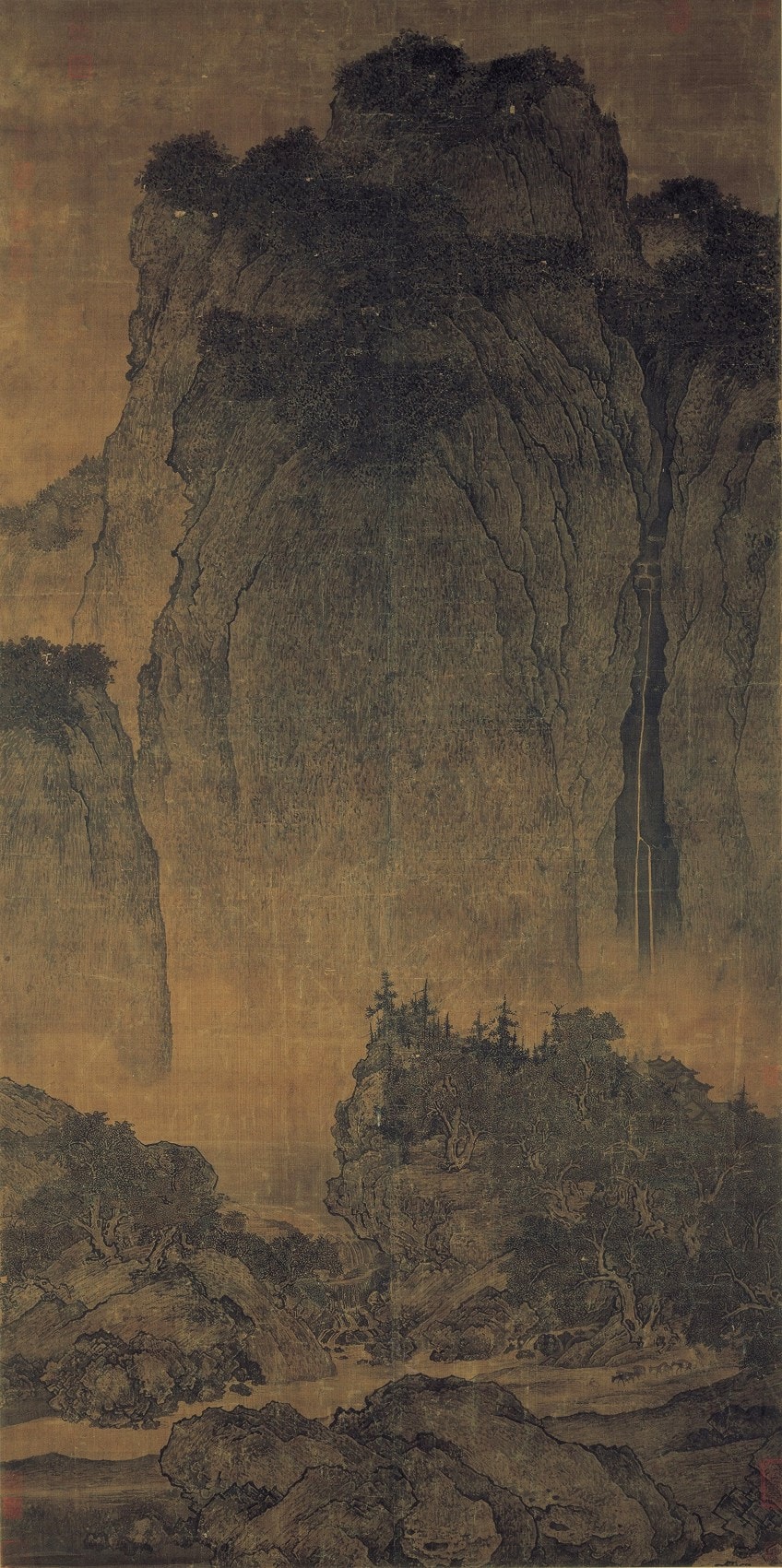 Travelers Among Mountains and Streams, Northern Song Dynasty (c. 1000) by Fan Kuan; Fan Kuan, Public domain, via Wikimedia Commons
Travelers Among Mountains and Streams, Northern Song Dynasty (c. 1000) by Fan Kuan; Fan Kuan, Public domain, via Wikimedia Commons
Kuan's composition reflects the classic Chinese style, dividing the painting into three, providing the viewer with a sense of distance, with a foreground, middle ground, and background. He skillfully positioned the weight to the background, the deep space that consumes the top of the Chinese painting on silk.
The heaviness at the top of the painting lends itself to the scale and sheer magnitude of the mountain that looms over the travelers on the path below and any viewer who stands before the painting.
Kuan's Travelers Among Mountains and Streams, Northern Song Dynasty is recognized as one of the triumphs of Chinese landscape artworks. Kuan's masterpiece has impacted countless generations of artists and continues to hold its own to this day. It established an ideal in the art of landscape paintings, which artists have returned to repeatedly for inspiration. Kuan was able to illustrate the imposing grandeur of the majestic landscape with realistic detail.
A Thousand Li of Rivers and Mountains (c. 1113) by Wang Ximeng
| Artist | Wang Ximeng |
| Date Painted | c. 1113 |
| Medium | Handscroll; ink and color on silk |
| Dimensions | 51.5 cm x 1191.5 cm |
| Where It Is Currently Housed | Palace Museum, Beijing, China |
Wang Ximeng was only 18 years old when he produced his masterpiece A Thousand Li of Rivers and Mountains, which has been recognized as a sensation of traditional Chinese artistry. Ximeng's painting stretches over 11 meters, with extensive details of ink and color on a silk scroll. It is Ximeng's only surviving art piece, who was born in 1096 and passed away at the age of 23 in 1119.
Ximeng was a prodigy and one of the most distinguished court painters from the Northern Song era (960–1127), who Emperor Huizong of Song guided.
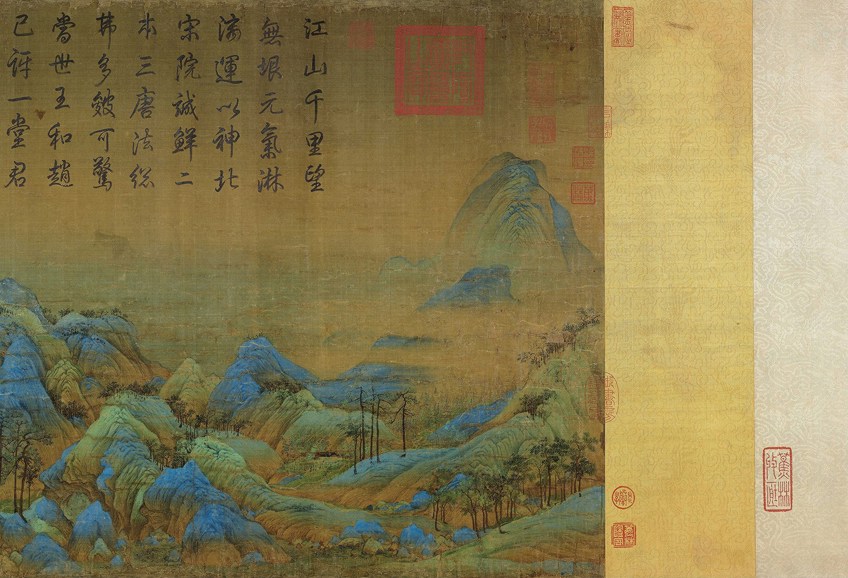 The beginning of A Thousand Li of Rivers and Mountains (c. 1113) by Wang Ximeng;Wang Ximeng (王希孟), Public domain, via Wikimedia Commons
The beginning of A Thousand Li of Rivers and Mountains (c. 1113) by Wang Ximeng;Wang Ximeng (王希孟), Public domain, via Wikimedia Commons
A Thousand Li of Rivers and Mountains is recognized as one of the largest paintings in Chinese history and remains one of the greatest works of Chinese artistry. Rare mineral pigments such as malachite green and azurite blue, with their vivid colors, were used to depict a prosperous and peaceful country.
It is regarded as one of the most exceptional examples of Chinese blue-green landscape artworks, a mode of painting established during the Tang Dynasty (618–907) when creating large landscapes.
 The center of A Thousand Li of Rivers and Mountains (c. 1113) by Wang Ximeng;Wang Ximeng (王希孟), Public domain, via Wikimedia Commons
The center of A Thousand Li of Rivers and Mountains (c. 1113) by Wang Ximeng;Wang Ximeng (王希孟), Public domain, via Wikimedia Commons
Ximeng's painting displays scattered perspectives, typical of ancient Chinese paintings of landscapes, there are three visual angles demonstrating depth, height, and level-distance. In his extensive depiction, we see the richness of the scene with its green mountains, cottages, bridges, and temples. When viewing A Thousand Li of Rivers and Mountains, one's line of sight follows the contours of the rivers and mountains with a panoramic view that seems endless.
Ancient Chinese paintings of landscapes usually serve as a metaphor for the Dynasty's boundless prosperity and the emperor's endurance.
 The end of A Thousand Li of Rivers and Mountains (c. 1113) by Wang Ximeng;Wang Ximeng (王希孟), Public domain, via Wikimedia Commons
The end of A Thousand Li of Rivers and Mountains (c. 1113) by Wang Ximeng;Wang Ximeng (王希孟), Public domain, via Wikimedia Commons
The rich hues that saturate the landscape, the nuanced details of the painting, and its sweeping scale all lend themselves to the brilliance of this masterpiece. Ximeng's meticulous technique and exceptional brushwork convey his immense admiration for nature's grandeur.
Mountains rise and fall amidst an empty sky, opening up a limitless landscape that we can explore endlessly.
Along the River During the Qingming Festival (Early 12th Century) by Zhang Zeduan
| Artist | Zhang Zeduan |
| Date Painted | Early 12th century |
| Medium | Handscroll; ink and colors on silk |
| Dimensions | 24.8 cm x 528.7 cm |
| Where It Is Currently Housed | Palace Museum, Beijing, China |
Along the River During the Qingming Festival , which is also known as Spring Festival on the River, is Zhang Zeduan's rare triumph. This ancient Chinese painting presents a bustling scene, depicting the lifestyle of all members of society. His painting details the nuances of class structures and the interaction of people during these festivities.
Zeduan's scroll stretches over five meters long, managing to encompass 814 people, 60 animals, 28 boats, 30 buildings, 170 trees, and 20 vehicles. It serves as an opportunity to explore remnants of the past.
This painting features two main parts, being the densely occupied city and the countryside. The right side depicts the rural area with farmers, crop fields, pig herders, and goatherds. While the left side depicts the urban area with all members of society, regardless of class.
 The first section of Along the River During the Qingming Festival (early 12th century) by Zhang Zeduan; Image provided by Baidu Tieba, Spliced by SJLD, CC0, via Wikimedia Commons
The first section of Along the River During the Qingming Festival (early 12th century) by Zhang Zeduan; Image provided by Baidu Tieba, Spliced by SJLD, CC0, via Wikimedia Commons
Zeduan depicted the landscape in his Chinese painting on silk, but instead of focusing on the immensity of nature, he aimed to capture the daily lives of the people of Bianjing, now known as Kaifeng. Zeduan's famous Asian paintings reveal what life was like in China from the 11th to the 12th century. For instance, Spring Festival on the River demonstrates that the bipod mast on the river ship would be lowered before traveling under the bridge.
Amazingly, we are offered a glimpse into the architecture and clothing of this period.
 A detail of Along the River During the Qingming Festival (early 12th century) by Zhang Zeduan; Zhang Zeduan, Public domain, via Wikimedia Commons
A detail of Along the River During the Qingming Festival (early 12th century) by Zhang Zeduan; Zhang Zeduan, Public domain, via Wikimedia Commons
Due to Zeduan's expert representation of life during the Song Dynasty, Spring Festival on the River has been copied, forged, and imitated time and time again. It has even gained the name: "China's Mona Lisa". Famous Chinese artists have produced a three-dimensional digital animation titled River of Wisdom that is thirty times bigger than the original scroll, which debuted at the Expo 2010 Shanghai China.
Now, "River of Wisdom" is featured in the China Art Museum's permanent exhibition in Shanghai.
Nymph of the Luo River (c. 344 – 406) by Gu Kaizhi (Song Dynasty Copy)
| Artist | Song Dynasty Copy of Gu Kaizhi |
| Date Painted | c. 1150–1250 |
| Medium | Handscroll; ink and color on silk |
| Dimensions | 24.2 cm x 310.9 cm |
| Where It Is Currently Housed | Palace Museum, Beijing, China |
Gu Kaizhi is largely considered the father of Chinese painting and one of the most famous Chinese artists from the Jin Dynasty (266–420). Kaizhi authored three books on painting theory, which had a profound impact on Chinese drawings and paintings for the centuries that followed. Unfortunately, none of his original Chinese drawings and paintings survive, but his artistry exists through exact copies made on silk handscroll paintings that have been attributed to him. One such example is the exceptional piece, Nymph of the Luo River.
An exact copy of Kaizhi's "Nymph of the Luo River" was made during the Song Dynasty (960–1279) and is currently housed in Beijing's Palace Museum.
The narrative silk handscroll illustrates the prince and poet, Cao Zhi's romantic poem from the period of the Three Kingdoms in the state of Wei. It depicts the imaginary meeting and ultimate separation of the Nymph of the Luo River and Cao Zhi. Each section of the painting furthers its story. The painting skillfully expresses the tension through its composition of mountains, trees, stones, and figures.
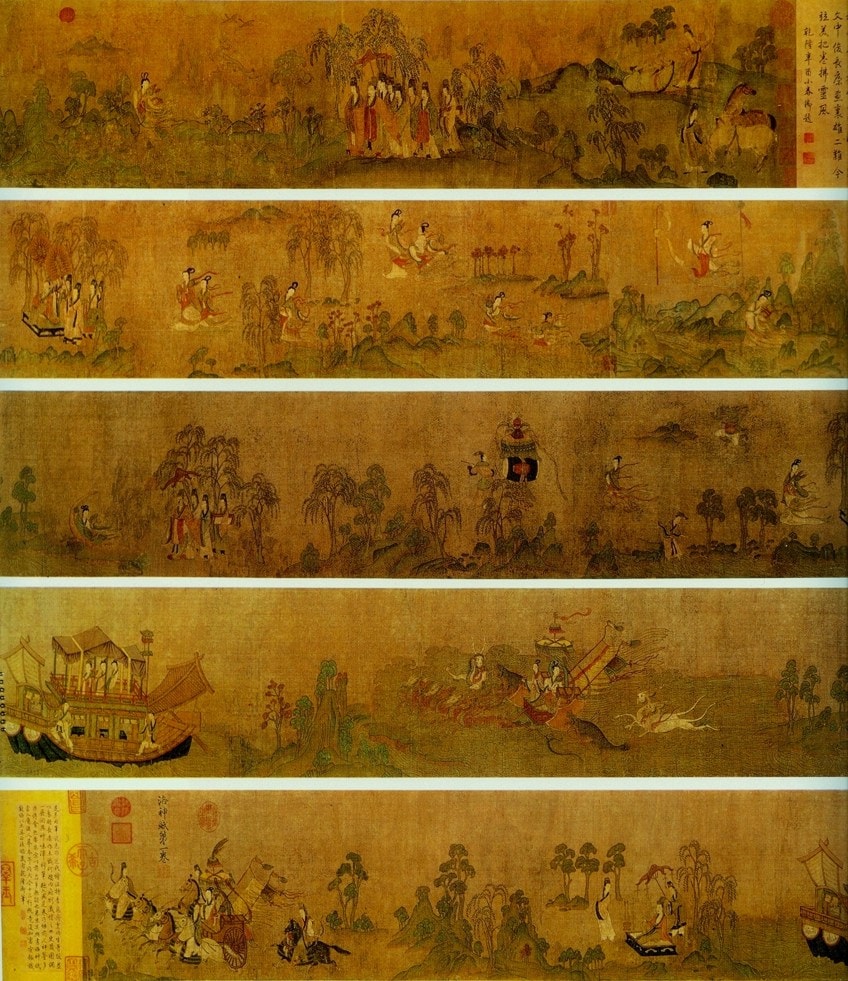 Nymph of the Luo River (c. 344-406) by Gu Kaizhi (Song Dynasty copy); Gu Kaizhi, Public domain, via Wikimedia Commons
Nymph of the Luo River (c. 344-406) by Gu Kaizhi (Song Dynasty copy); Gu Kaizhi, Public domain, via Wikimedia Commons
The painting was crafted in light colors. Outlines were used to define the figures, mountains, trees, and clouds, which were then filled with washes of color. The figures were elegantly drawn and their garments, particularly the ribbons, were painted so delicately that it is as if one can imagine the breeze billowing through them. The landscape appears smaller than the figures, merely acting as the stage for the plot.
Only around half of the painting's original length still exists, but it remains a key representation of a Southern Song copy of an earlier composition.
Kaizhi's attention to detail was inspiring, he is known for portraying vivid facial expressions and his ability to capture the spirit of his subjects in his Chinese portraits and Chinese drawings. As simplistic as some elements may seem, each landscape feature works together seamlessly to produce a coherent and harmonious composition. Nymph of the Luo River is one of the most important ancient Chinese paintings, pioneering the evolution of Chinese landscape painting.
Emperor Taizong Receiving the Tibetan Envoy (14th Century) by Yan Liben
| Artist | Yan Liben |
| Date Painted | 14th century |
| Medium | Handscroll; ink and color on silk |
| Dimensions | 129.6 cm x 38.5 cm |
| Where It Is Currently Housed | Palace Museum, Beijing, China |
Yan Liben is one of the most famous Chinese artists from the Tang Dynasty (618–907). Emperor Taizong Receiving the Tibetan Envoy is a Chinese painting on silk that sits at 129.6 cm in length and 38.5 cm in width. Liben's masterpiece was collected by Beijing's Palace Museum. This famous Chinese painting's value is not only in its artistry but its historical significance.
The scene depicted illustrates a historic event that defined the course of history for Tibet and China, a favorable encounter between Tibet and the Tang Dynasty.
Emperor Taizong Receiving the Tibetan Envoy represents the marriage of Songsten Gampo, the Tibetan King, to Emperor Taizong's daughter in 634. Harmony is very important in famous Asian paintings and Liben's Emperor Taizong Receiving the Tibetan Envoy demonstrates this with its subtle and salient contrasts.
 Emperor Taizong Receiving the Tibetan Envoy (14th century) by Yan Liben; Yan Liben, Public domain, via Wikimedia Commons
Emperor Taizong Receiving the Tibetan Envoy (14th century) by Yan Liben; Yan Liben, Public domain, via Wikimedia Commons
Liben's careful composition skillfully divides the painting into a balanced depiction of two groups of figures. The emperor is seated on a sedan and encircled by ladies of the court that frame him with fans and a canopy overhead. The emperor's size dominates the frame in comparison to the figures that surround him. A royal court official in red stands before the emperor, with the envoy standing aside formally, who holds the seated Emperor in awe. Lastly, an interpreter stands behind the two officials.
Liben crafted with a traditional Chinese drawing technique that used fine lines to produce vivid forms and figures.
Liben's use of bright colors evokes a particularly festive atmosphere. Emperor Taizong Receiving the Tibetan Envoy is likely a faithful copy of an earlier original painting by Liben, which is suggested to be from the Song Dynasty (960–1279). However, the additional comments and seals provided by the Imperial collector demonstrate that it was a highly valued piece of work from at least the beginning of the 14th-century.
Spring Morning in the Han Palace (c. 1552) by Qiu Ying
| Artist | Qiu Ying |
| Date Painted | c. 1552 |
| Medium | Handscroll; ink and colors on silk |
| Dimensions | 30.6 cm x 574.1 cm |
| Where It Is Currently Housed | National Palace Museum, Taipei, Taiwan |
Qiu Ying was considered one of Ming Dynasty's (1368–1644) Four Great Masters. Ying depicted several scenes from the ladies' quarters of the Han Palace during the Han Dynasty (206 BC–220 CE). The captivating quality of long scroll paintings is their capacity to simultaneously present chronological progression and segmentation. Scenes taking place at different times were regularly portrayed on the same scroll.
With the painting's scale and the traditional right-to-left direction of reading, the painting compositions unfold accordingly.
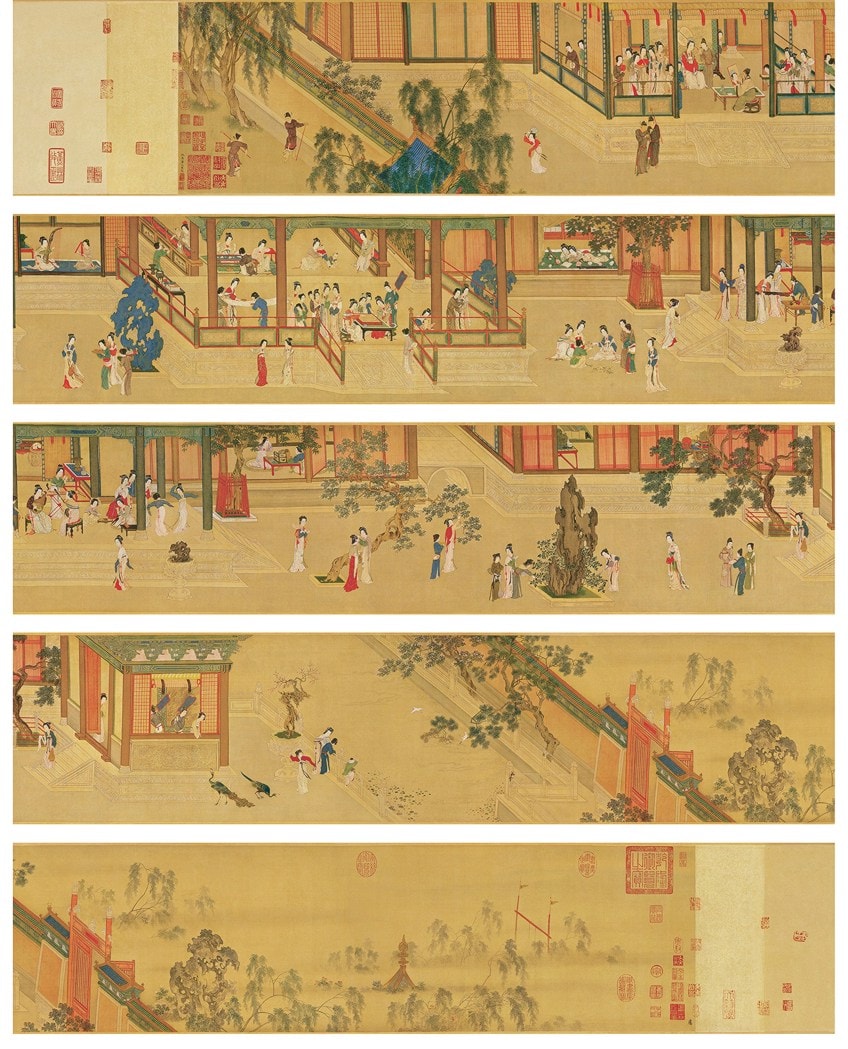 Spring Morning in the Han Palace (c. 1552) by Qiu Ying; Qiu Ying, Public domain, via Wikimedia Commons
Spring Morning in the Han Palace (c. 1552) by Qiu Ying; Qiu Ying, Public domain, via Wikimedia Commons
Among the scenes Ying depicted in Spring Morning in the Han Palace we find the well-known story of the artist Mao Yanshou doing one of his famous Chinese portraits of Wang Zhaojun. The story goes as follows, the artist Yanshou was ordered to create Chinese portraits of Emperor Yuandi's concubines, as there were so many of them. The concubines would bribe Yanshou to make them look more beautiful in his paintings, all but the righteous Zhaojun.
Out of spite, Yanshou portrayed Zhaojun as ugly in her portrait.
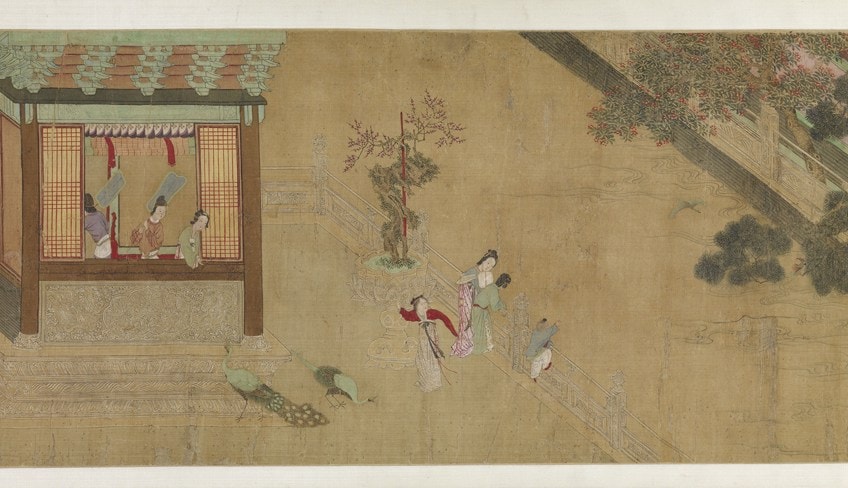 A close-up of Spring Morning in the Han Palace (c. 1552) by Qiu Ying;Qiu Ying, Public domain, via Wikimedia Commons
A close-up of Spring Morning in the Han Palace (c. 1552) by Qiu Ying;Qiu Ying, Public domain, via Wikimedia Commons
When a chieftain visited the palace looking for a wife, the emperor who believed in Yanshou's portraits, picked Zhaojun as he thought she would be the most unattractive. When the Emperor eventually saw her, he realized that she was actually the most beautiful concubine. The emperor was infuriated and felt deceived by Yanshou, thus ordering him to be executed.
Ying was particularly talented in the brush technique known as "Gongbi". He accomplished a complex composition throughout his painting, with pure and strong brushwork, and rich elegant colors.
As the painting's perspective is somewhat higher than the building structures, the viewer is given a panoramic view of the scene. The handscroll introduces the palace gates and leads the viewer through opulent courtyards. There are gardens and trees interspersed amidst the palace buildings, depicting a spectacular scene as if the viewer is witnessing a realm of immortals.
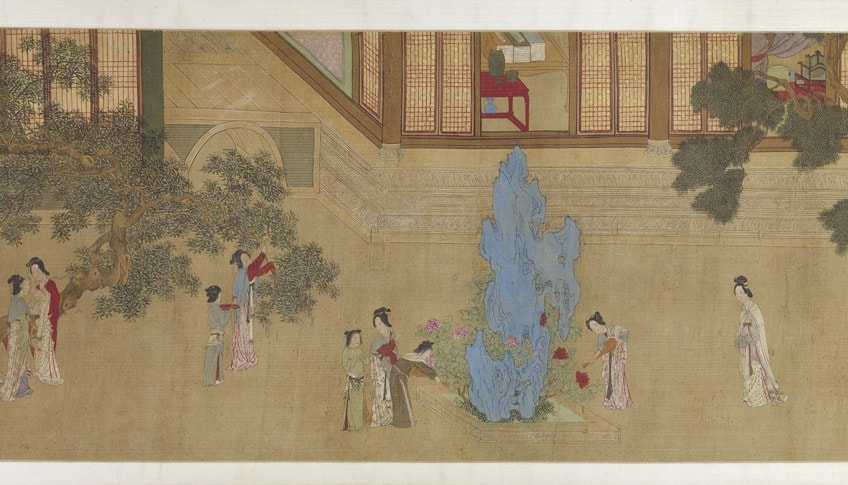 A close-up of Spring Morning in the Han Palace (c. 1552) by Qiu Ying;Qiu Ying, Public domain, via Wikimedia Commons
A close-up of Spring Morning in the Han Palace (c. 1552) by Qiu Ying;Qiu Ying, Public domain, via Wikimedia Commons
Here, court ladies are elegantly depicted engaging in a variety of leisurely affairs of the literati, including chess, painting, zither, calligraphy, planting flowers, and admiring antiquities. Ying used his painting to portray a peaceful court life. Ying expertly depicted sumptuous furnishings and accurate architectural structures. The court ladies' dresses were modeled after those in the Tang (618–907) and Song Dynasties (960–1279).
The National Palace Museum in Taipei, where Ying's painting sits today, has installed a high-resolution animation of the long scroll.
These projections seamlessly unfold scenes from famous Asian paintings, capturing the spirit of the artworks which inspired them. Spring Morning in the Han Palace represents a fantastic effort by Ying to maintain a historical narrative, drawing inspiration from the past. Ying made an effort to learn from his former generation's painting style while blending contemporary details and aesthetic components.
Flower Study (17th Century) by Yun Bing
| Artist | Yun Bing |
| Date Painted | 17th century |
| Medium | Album leaf; ink and color on paper |
| Dimensions | 31.1 cm x 34.3 cm |
| Where It Is Currently Housed | Metropolitan Museum of Art, New York, the United States |
Female artists throughout history have rarely been acknowledged or recognized for their talents and contribution to the arts. The works of these veiled artists have been largely overshadowed by their male counterparts, but also their records are exceptionally rare and limited. Luckily there are a few ancient Chinese female artists who have had their artworks protected and well preserved.
Yun Bing forms part of this group of artists, famed as one of the most well-known female artists from the Qing Dynasty (1644–1912).
Bing's Flower Study is an album leaf painting with ink and color on paper. Bing excelled at painting birds and flowers, and her works were recognized for bearing strong feminine character. Bing expertly executed the "boneless" technique, which is a traditional Chinese painting technique where forms are made using color washes and ink rather than using outlines.
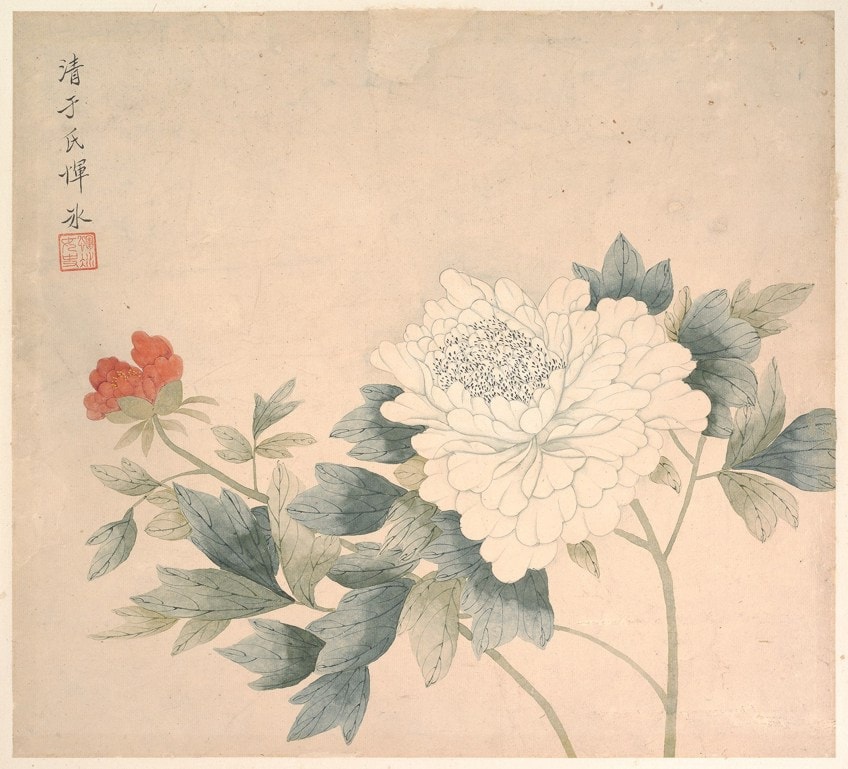 Flower Study (17th century) by Yun Bing; Yun Bing, CC0, via Wikimedia Commons
Flower Study (17th century) by Yun Bing; Yun Bing, CC0, via Wikimedia Commons
The majority of bird-and-flower paintings belonged to the scholar-artist style of famous Chinese art and were largely practiced in East Asia. Bing was the most famous female artist in the Yun family. Bing's work was displayed to the Empress Dowager Chongqing by Yi Jishan, who then presented it to the Qianlong emperor.
Bing's work was so impressive, that it reportedly inspired the emperor to write a poem that celebrated her Chinese paintings and garnered her great attention and praise– justifying her reputation as a phenomenal artist.
Flowers and Butterflies (Early 18th Century) by Ma Quan
| Artist | Ma Quan |
| Date Painted | Early 18th century |
| Medium | Handscroll; ink and color on paper |
| Dimensions | 27.9 cm x 248.9 cm |
| Where It Is Currently Housed | Metropolitan Museum of Art, New York, the United States |
Ma Quan was another famous female Chinese artist from the Qing Dynasty (1644–1912). As an artist, Quan specialized in bird-and-flower style paintings, but her style was noticeably different from her contemporaries and the imperial court. Although there is very little documented information regarding Quan's life, we know she was alive during the late 17th to 18th centuries. It is suggested that Quan was born in Changshu and that Ma Yuanyu, the artist-scholar, was reportedly her father or grandfather.
Quan's famous Chinese paintings earned her great acclaim, with her works being compared favorably to artists such as Shen Zhou, a painter from the Ming Dynasty (1368–1644).
Quan's painting Flowers and Butterflies is a handscroll with ink and color. Quan's famous Asian paintings have been recognized for their adherence to the fine brush with a freehand style. Her artwork is often compared to the previous artist we mentioned, Yun Bing, who also concentrated on bird-and-flower painting, but Quan's work favored strong outlines and silhouettes.
 Flowers and Butterflies (early 18th century) by Ma Quan; Metropolitan Museum of Art, CC0, via Wikimedia Commons
Flowers and Butterflies (early 18th century) by Ma Quan; Metropolitan Museum of Art, CC0, via Wikimedia Commons
Quan's famous Asian paintings had captivating brushwork that conveyed an aesthetic essence. She gained a great deal of popularity, which led many people in Changshu, especially women, to request tuition from her. Quan's work was largely inspired by the art styles of the Song Dynasty (960–1279).
Quan began painting bird-and-flower paintings as a means to earn money when her husband experienced financial strain. Later in her life, Quan became blind and sold her students' paintings with her signature on them.
Flowers and Butterflies' exhibition history started at the Philadelphia Museum of Art in 1963. From there, it moved along the States to the Phoenix Art Museum and then to the Santa Barbara Museum of Art. Since then, the famous Chinese artwork has been part of two exhibitions at the Hong Kong Museum of Art, then making its way back to several more exhibitions at various esteemed museums in the United States, lastly finding its place at the Metropolitan Museum of Art.
Twin Swallows (1981) by Wu Guanzhong
| Artist | Wu Guanzhong |
| Date Painted | 1981 |
| Medium | Ink and color on paper |
| Dimensions | 68.5 cm x 137.4 cm |
| Where It Is Currently Housed | Hong Kong Museum of Art, Hong Kong |
Wu Guanzhong is widely recognized as one of the pioneers of Modern art in China. Guanzhong crafted Twin Swallows in 1981 from a sketch that he made a year earlier of the Jiangnan area in China. Guanzhong believed that Twin Swallows was the most representative and outstanding Chinese painting from his collection of paintings of the Jiangnan area. Twin Swallows encouraged Guanzhong to explore how he could blend his learnings from the West with his Eastern expertise.
Guanzhong ingeniously fused techniques of Western oil painting with those of Chinese ink painting.
He painted his native land with minimalism and geometric simplicity that was typical of the Mondrian style. He illustrated elegant depictions of landscapes in the Chinese countryside. The color scheme of Twin Swallows mainly features tones of silvery gray. Guanzhong wanted to capture the essence of Jiangnan on overcast days, removing the effects of harsh sunlight and its shadows.
Guanzhong's adoption of a Western artistic approach marked him as a target during China's Cultural Revolution.
He was condemned to spending two years in a labor camp. This led to many of his works being destroyed. Only after the death of Mao in 1976 could he return to exhibiting his artworks. Guanzhong's first solo exhibition took place in 1976. In 1992 he exhibited his work at the British Museum, making him the first living Chinese artist to hold a solo exhibition there. To this day Guanzhong is regarded as a seminal 20th-century Chinese artist.
Our selection of the 10 most famous Chinese paintings only unveils a small fraction of the incredible expertise and intricate artistry that centuries of brilliant artists have produced in China. If you are interested in reading more about the history of Chinese art, we have another article on our website we think you would enjoy! There you will find a vast selection of art topics that are worth exploring!
Frequently Asked Questions
What Are the Main Types of Chinese Paintings?
Many of the famous Chinese paintings held in high regard were landscape paintings, as they were seen as the highest form of art in China. Chinese artists have produced some of the world's greatest landscape paintings. The so-called great age of Chinese landscapes took place from 907 to 1127, from the Five Dynasties to the era of the Northern Song Dynasty. Artists from the north such as Fan Kuan, the second name on our list, painted monumental mountains, using powerful black lines and ink wash techniques. Jagged stones were illustrated with dotted and sharp brushstrokes. Artists from the south painted using softer, blended brushwork to portray their native surroundings in peaceful scenes with serene rivers and rolling hills. These two distinct styles and their respective techniques illustrated the classical styles of landscape painting in China.
What Are the Characteristics of Chinese Paintings?
Chinese artists over the centuries have crafted brilliant depictions of nature, figures, and animals with expert precision and detail. These artworks display an array of distinctive styles and remarkable characteristics that record China's storied art history and reflect its magnificent landscapes. There were two primary techniques used for ancient Chinese paintings. The first technique is known as Gongbi, which translates to meticulous, where artists would capture scenes and figures with very precise and detailed brushstrokes. The results were often saturated in color, depicting narrative or figural subjects. This style was a popular choice for artists who worked in private workshops or for the royal court. The second technique is ink and wash painting, which has also been referred to as brush or watercolor painting, and literati painting. This technique was practiced mainly by gentlemen. The paintings were typically monochrome and were achieved by using black ink in varying concentrations.
Why Is Chinese Art Important?
Art is an incredibly important component of Chinese culture and heritage. China is one of the oldest civilizations in the world, with a continuous history that spans thousands of years. As one of the most culturally distinct nations, China has a rich art history. Traditional Chinese artists distinctly aimed to capture the subject's inner essence – its spirit, life force, and energy, as well as elegantly illustrate its outer appearance.
stewartyounsholve.blogspot.com
Source: https://artincontext.org/famous-chinese-paintings/
0 Response to "Traditional Chinese Artists Used the Oldest Painting Medium in Continuous Use"
Post a Comment